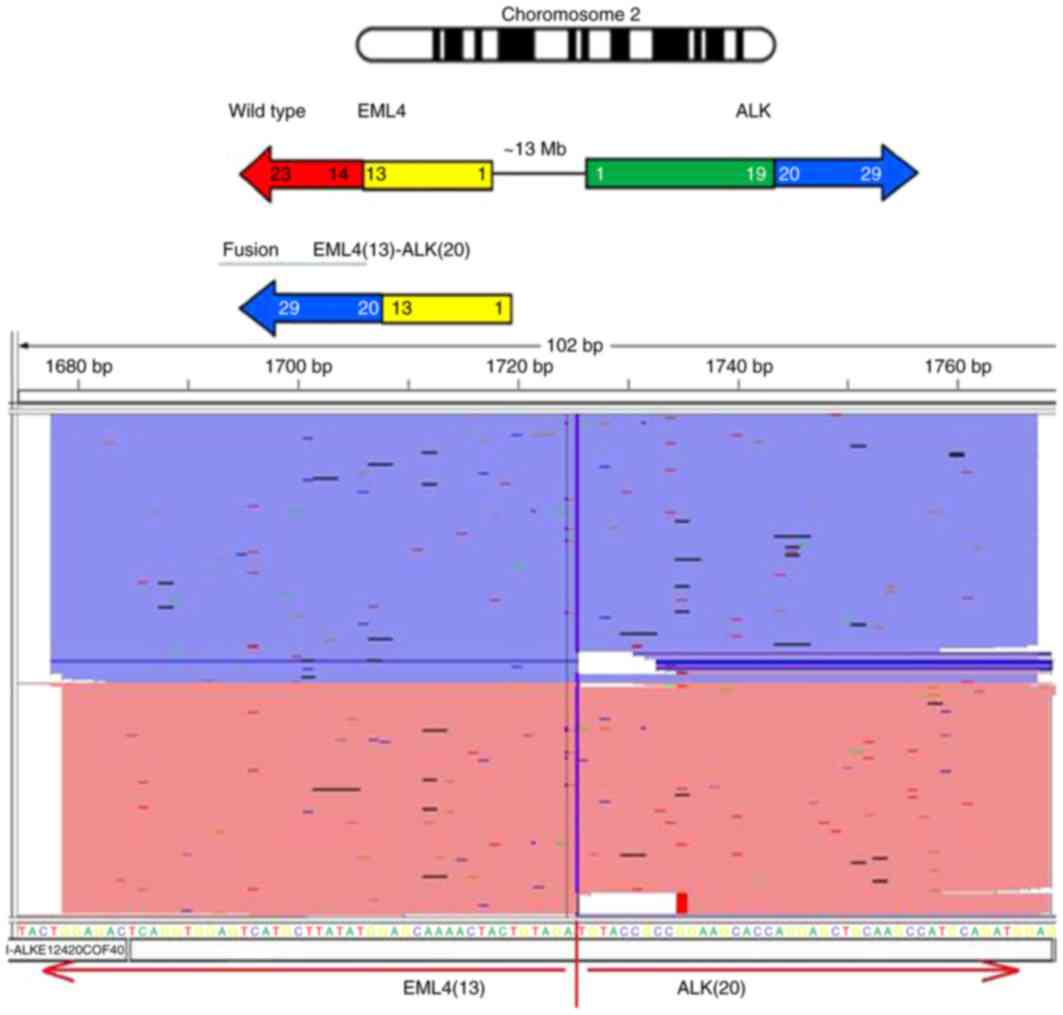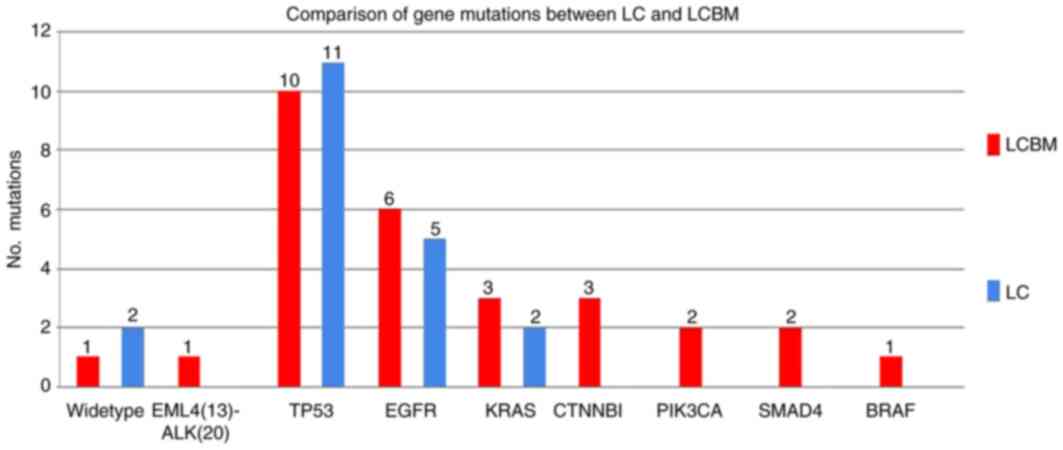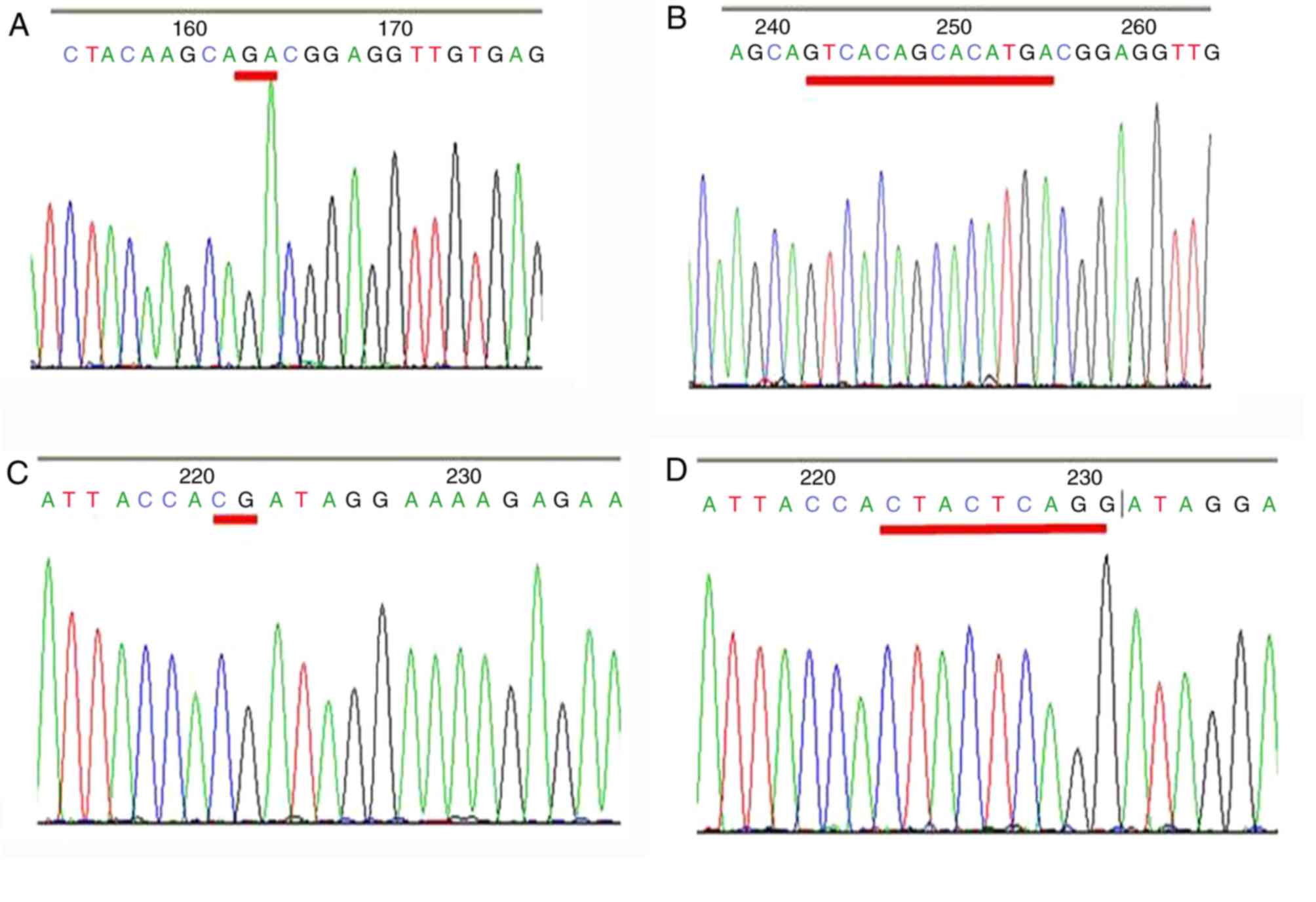|
1
|
Mulvenna PM: The management of brain
metastases in patients with non-small cell lung cancer is it time
to go back to the drawing board? Clin Oncol (R Coll Radiol).
22:365–373. 2010. View Article : Google Scholar : PubMed/NCBI
|
|
2
|
Ting CY, Fan CH, Liu HL, Huang CY, Hsieh
HY, Yen TC, Wei KC and Yeh CK: Concurrent blood-brain barrier
opening and local drug delivery using drug-carrying microbubbles
and focused ultrasound for brain glioma treatment. Biomaterials.
33:704–712. 2012. View Article : Google Scholar : PubMed/NCBI
|
|
3
|
Cardarella S and Johnson BE: The impact of
genomic changes on treatment of lung cancer. Am J Respir Crit Care
Med. 188:770–775. 2013. View Article : Google Scholar : PubMed/NCBI
|
|
4
|
Lindman NI, Cagle PT, Beasley MB, Chitale
DA, Dacic S, Giaccone G, Jenkins RB, Kwiatkowski DJ, Saldivar JS,
Squire J, et al: Molecular testing guidelines for selection of lung
cancer patients for EGFR and ALK tyrosine kinase inhibitors:
Guideline from the College of American Pathologists, International
Association for the Study of Lung Cancer, and Association for
Molecular Pathology. J Thorac. 8:823–859. 2013. View Article : Google Scholar
|
|
5
|
Tartarone A, Lazzari C, Lerose R,
Conteduca V, Improta G, Zupa A, Bulotta A, Aieta M and Gregorc V:
Mechanisms of resistance to EGFR tyrosine kinase inhibitors
gefitinib/erlotinib and to ALK inhibitor crizotinib. Lung Cancer.
81:328–336. 2013. View Article : Google Scholar : PubMed/NCBI
|
|
6
|
Lindeman NI, Cagle PT, Beasley MB, Chitale
DA, Dacic S, Giaccone G, Jenkins RB, Kwiatkowski DJ, Saldivar JS,
Squire J, et al: Molecular testing guideline for selection of lung
cancer patients for EGFR and ALK tyrosine kinase inhibitors:
guideline from the College of American Pathologists, International
Association for the Study of Lung Cancer, and Association for
Molecular Pathology. Arch Pathol Lab Med. 137:828–860. 2013.
View Article : Google Scholar : PubMed/NCBI
|
|
7
|
Shaw AT, Ou SH, Bang YJ, Camidge DR,
Solomon BJ, Salgia R, Riely GJ, Varella-Garcia M, Shapiro GI, Costa
DB, et al: Crizotinib in ROS1-rearranged non-small-cell lung
cancer. N Engl J Med. 371:1963–1971. 2014. View Article : Google Scholar : PubMed/NCBI
|
|
8
|
Zer A and Leighl N: Promising targets and
current clinical trials in metastatic non-squamous NSCLC. Front
Oncol. 4:3292014. View Article : Google Scholar : PubMed/NCBI
|
|
9
|
Welsh JW, Komaki R, Amini A, Munsell MF,
Unger W, Allen PK, Chang JY, Wefel JS, McGovern SL, Garland LL, et
al: Phase II trial of erlotinib plus concurrent whole-brain
radiation therapy for patients with brain metastases from
non-small-cell lung cancer. J Clin Oncol. 31:895–902. 2013.
View Article : Google Scholar : PubMed/NCBI
|
|
10
|
Gadgeel SM, Gandhi L, Riely GJ, Chiappori
AA, West HL, Azada MC, Morcos PN, Lee RM, Garcia L, Yu L, et al:
Safety and activity of alectinib against systemic disease and brain
metastases in patients with crizotinib-resistant ALK-rearranged
non-small-cell lungcancer (AF-002JG): Results from the dose-finding
portion of aphase 1/2 study. Lancet Oncol. 15:1119–1128. 2014.
View Article : Google Scholar : PubMed/NCBI
|
|
11
|
Robinson SD, O'Shaughnessy JA, Cowey CL
and Konduri K: BRAF V600E-mutated lung adenocarcinoma with
metastases to the brain responding to treatment with vemurafenib.
Lung Cancer. 85:326–330. 2014. View Article : Google Scholar : PubMed/NCBI
|
|
12
|
Preusser M, Berghoff AS, Koller R,
Zielinski CC, Hainfellner JA, Liebmann-Reindl S, Popitsch N, Geier
CB, Streubel B and Birner P: Spectrum of gene mutations detected by
next generation exome sequencing in brain metastases of lung
adenocarcinoma. Eur J Cancer. 51:1803–1811. 2015. View Article : Google Scholar : PubMed/NCBI
|
|
13
|
Ellis MJ, Ding L, Shen D, Luo J, Suman VJ,
Wallis JW, Van Tine BA, Hoog J, Goiffon RJ, Goldstein TC, et al:
Whole-genome analysis informs breast cancer response to aromatase
inhibition. Nature. 486:353–360. 2012.PubMed/NCBI
|
|
14
|
Boland GM, Piha-Paul SA, Subbiah V,
Routbort M, Herbrich SM, Baggerly K, Patel KP, Brusco L, Horombe C,
Naing A, et al: Clinical next generation sequencing to identify
actionable aberrations in a phase I program. Oncotarget.
6:20099–20110. 2015. View Article : Google Scholar : PubMed/NCBI
|
|
15
|
Movva S, Wen W, Chen W, Millis SZ,
Gatalica Z, Reddy S, von Mehren M and Van Tine BA: Multi-platform
profiling of over 2000 sarcomas: Identification of biomarkers and
novel therapeutic targets. Oncotarget. 6:12234–12247. 2015.
View Article : Google Scholar : PubMed/NCBI
|
|
16
|
Sie D, Snijders PJ, Meijer GA, Doeleman
MW, van Moorsel MI, van Essen HF, Eijk PP, Grünberg K, van Grieken
NC, Thunnissen E, et al: Performance of amplicon-based next
generation DNA sequencing for diagnostic gene mutation profiling in
oncopathology. Cell Oncol (Dordr). 37:353–361. 2014. View Article : Google Scholar : PubMed/NCBI
|
|
17
|
Hagemann IS, Devarakonda S, Lockwood CM,
Spencer DH, Guebert K, Bredemeyer AJ, Al-Kateb H, Nguyen TT,
Duncavage EJ, Cottrell CE, et al: Clinical next-generation
sequencing in patients with non-small cell lung cancer. Cancer.
121:631–639. 2015. View Article : Google Scholar : PubMed/NCBI
|
|
18
|
Frampton GM, Fichtenholtz A, Otto GA, Wang
K, Downing SR, He J, Schnall-Levin M, White J, Sanford EM, An P, et
al: Development and validation of a clinical cancer genomic
profiling test based on massively parallel DNA sequencing. Nat
Biotechnol. 31:1023–1031. 2013. View
Article : Google Scholar : PubMed/NCBI
|
|
19
|
Detterbeck FC, Boffa DJ, Kim AW and Tanoue
LT: The 8th edition lung cancer stage classification. CHEST.
151:193–203. 2017. View Article : Google Scholar : PubMed/NCBI
|
|
20
|
Torre LA, Bray F, Siegel RL, Ferlay J,
Lortet-Tieulent J and Jemal A: Global cancer statistics, 2012. CA
Cancer J Clin. 65:87–108. 2015. View Article : Google Scholar : PubMed/NCBI
|
|
21
|
Bailon O, Kallel A, Chouahnia K, Billot S,
Ferrari D and Carpentier AF: Management of brain metastases from
non-small cell lung carcinoma. Rev Neurol (Paris). 167:579–591.
2011.(In French). View Article : Google Scholar : PubMed/NCBI
|
|
22
|
Lemjabbar-Alaoui H, Hassan OU, Yang YW and
Buchanan P: Lung cancer: Biology and treatment options. Biochim
Biophys Acta. 1856:189–210. 2015.PubMed/NCBI
|
|
23
|
Andrews DW, Scott CB, Sperduto PW,
Flanders AE, Gaspar LE, Schell MC, Werner-Wasik M, Demas W, Ryu J,
Bahary JP, et al: Whole brain radiation therapy with or without
stereotactic radio surgery boost for patients with one to three
brain metastases: Phase III results of the RTOG 9508 randomised
trial. Lancet. 363:1665–1672. 2004. View Article : Google Scholar : PubMed/NCBI
|
|
24
|
Cancer Genome Atlas Research Network, .
Comprehensive molecular profiling of lung adenocarcinoma. Nature.
511:543–550. 2014. View Article : Google Scholar : PubMed/NCBI
|
|
25
|
Imielinski M, Berger AH, Hammerman PS,
Hernandez B, Pugh TJ, Hodis E, Cho J, Suh J, Capelletti M,
Sivachenko A, et al: Mapping the hallmarks of lung adenocarcinoma
with massively parallel sequencing. Cell. 150:1107–1120. 2012.
View Article : Google Scholar : PubMed/NCBI
|
|
26
|
Dienstmann R, Rodon J, Barretina J and
Tabernero J: Genomic medicine frontier in human solid tumors:
Prospects and challenges. J Clin Oncol. 31:1874–1884. 2013.
View Article : Google Scholar : PubMed/NCBI
|
|
27
|
Russo A, Franchina T, Ricciardi GR, Picone
A, Ferraro G, Zanghì M, Toscano G, Giordano A and Adamo V: A decade
of EGFR inhibition in EGFR-mutated non small cell lung cancer
(NSCLC): Old successes and future perspectives. Oncotarget.
6:26814–26825. 2015. View Article : Google Scholar : PubMed/NCBI
|
|
28
|
Mao C, Qiu LX, Liao RY, Du FB, Ding H,
Yang WC, Li J and Chen Q: KRAS mutations and resistance to
EGFR-TKIs treatment in patients with non-small cell lung cancer: A
meta-analysis of 22 studies. Lung Cancer. 69:272–278. 2010.
View Article : Google Scholar : PubMed/NCBI
|
|
29
|
Riely GJ, Kris MG, Rosenbaum D, Marks J,
Li A, Chitale DA, Nafa K, Riedel ER, Hsu M, Pao W, et al: Frequency
and distinctive spectrum of KRAS mutations in never smokers with
lung adenocarcinoma. Clin Cancer Res. 14:5731–5734. 2008.
View Article : Google Scholar : PubMed/NCBI
|
|
30
|
Arrieta O, Cardona AF, Martín C, Más-López
L, Corrales-Rodríguez L, Bramuglia G, Castillo-Fernandez O,
Meyerson M, Amieva-Rivera E, Campos-Parra AD, et al: Updated
frequency of EGFR and KRAS mutations in non-small-cell lung cancer
in Latin America: The Latin-American Consortium for the
Investigation of Lung Cancer (CLICaP). J Thorac Oncol. 10:838–843.
2015. View Article : Google Scholar : PubMed/NCBI
|
|
31
|
Zheng D, Wang R, Zhang Y, Pan Y, Cheng X,
Cheng C, Zheng S, Li H, Gong R, Li Y, et al: The prevalence and
prognostic significance of KRAS mutation subtypes in lung
adenocarcinomas from Chinese populations. Onco Targets Ther.
9:833–843. 2016. View Article : Google Scholar : PubMed/NCBI
|
|
32
|
Paik PK, Shen R, Won H, Rekhtman N, Wang
L, Sima CS, Arora A, Seshan V, Ladanyi M, Berger MF and Kris MG:
Next generation sequencing of stage IV squamous cell lung cancers
reveals an association of PI3K aberrations and evidence of clonal
heterogeneity in patients with brain metastases. Cancer Discov.
5:610–621. 2015. View Article : Google Scholar : PubMed/NCBI
|
|
33
|
Yanagisawa K, Uchida K, Nagatake M, Masuda
A, Sugiyama M, Saito T, Yamaki K, Takahashi T and Osada H:
Heterogeneities in the biological and biochemical function of Smad2
and Smad4 mutants naturally occurring in human lung cancers.
Oncogene. 19:2305–2311. 2000. View Article : Google Scholar : PubMed/NCBI
|
|
34
|
Gallione CJ, Repetto CJ, Legius E, Rustgi
AK, Schelley SL, Tejpar S, Mitchell G, Drouin E, Westermann CJ and
Marchuk DA: A combined syndrome of juvenile polyposis and
hereditary haemorrhagic telangiectasia associated with mutations in
MADH4 (SMAD4). Lancet. 363:852–859. 2004. View Article : Google Scholar : PubMed/NCBI
|
|
35
|
Yu JR, Tai Y, Jin Y, Hammell MC, Wilkinson
JE, Roe JS, Vakoc CR and Van Aelst L: TGF-β/Smad signaling through
DOCK4 facilitates lung adenocarcinoma metastasis. Genes Dev.
29:250–261. 2015. View Article : Google Scholar : PubMed/NCBI
|
|
36
|
Kitaewa MN, Grogan L, Williams JP, Dimond
E, Nakahara K, Hausner P, DeNobile JW, Soballe PW and Kirsch IR:
Mutations in beta-catenin are uncommon in colorectal cancer
occurring in occasional replication error-positive tumors. Cancer
Res. 57:4478–4481. 1997.PubMed/NCBI
|
|
37
|
Mäki-Nevala S, Sarhadi VK, Rönty M,
Kettunen E, Husgafvel-Pursiainen K, Wolff H, Knuuttila A and
Knuutila S: Hot spot mutations in Finnish non-small cell lung
cancers. Lung Cancer. 99:102–110. 2016. View Article : Google Scholar : PubMed/NCBI
|
|
38
|
Han ES, Moyer MP, Naylor S and Sakaguchi
AY: Mutation in the TP53 gene in colorectal carcinoma detected by
polymerase chain reaction. Genes Chromosomes Cancer. 3:313–317.
1991. View Article : Google Scholar : PubMed/NCBI
|
|
39
|
Lai MY, Chang HC, Li HP, Ku CK, Chen PJ,
Sheu JC, Huang GT, Lee PH and Chen DS: Splicing mutations of the
p53 gene in human hepatocellular carcinoma. Cancer Res.
53:1653–1656. 1993.PubMed/NCBI
|














